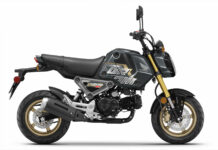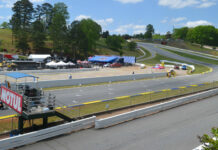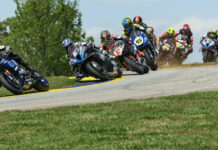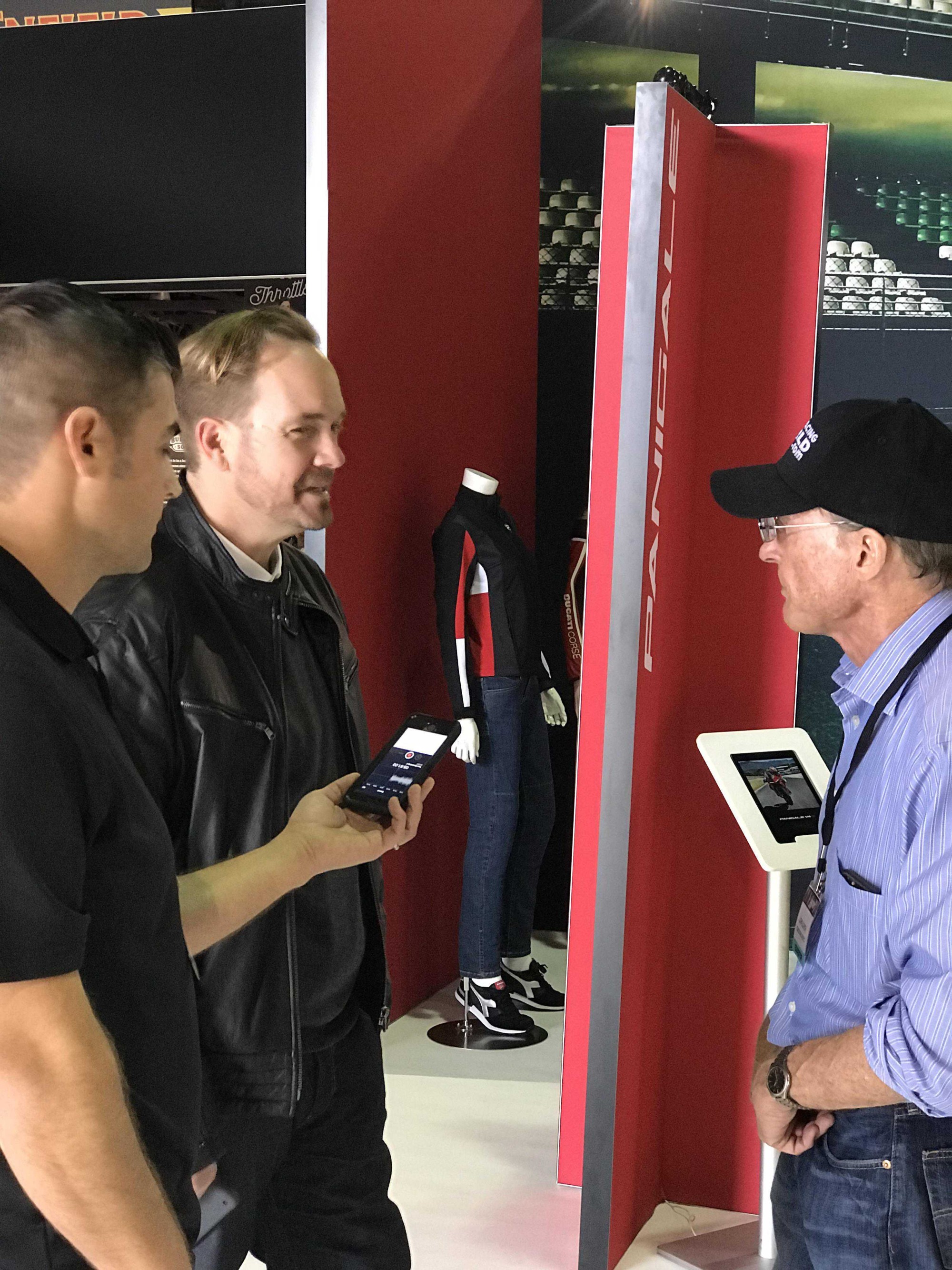What follows is our interview with Ducati North America CEO Jason Chinnock, which started with Roadracing World Editor John Ulrich asking him how important the 2018 Ducati Panigale V4–and sportbikes in general–are to Ducati.

Ducati North America CEO Jason Chinnock and a 2018 Ducati Panigale V4. Photo by David Swarts, copyright Roadracing World Publishing, Inc.
Jason Chinnock: “It’s who we are. Maybe it wasn’t exactly who we [were when we] started out, when the Cucciolo came to market, but when the Cucciolo came to market the first thing people did was hot-rod them and make them go faster and start racing them. So, it was one of those things that even years ago we kind of fell into, but we’ve adopted it and we’ve embraced it. If you look at what we’ve done with the development of the new V4 and the investment that we put into this project, it’s very relevant to us on a global level to be relevant in the sportbike world.
“I think probably for us maybe more so than other people is that everything starts here for us. Everything comes from here, and like, for example, the development of new products, a lot of the technology it starts on the track. It goes to maybe this bike or these bikes here. And then it works its way to other motorcycles within the line-up on the street.
“You can probably read in the [Panigale V4] press release where it talks about the technology that we’ve pulled directly out of MotoGP. It’s made its way into the development of this engine. The twin-pulse firing order, the counter-rotating crankshaft, the Desmodromic valve actuating system and how it’s utilized in this motorcycle. How are we going to get better? People come to us because they want always to be on the, let’s say, cutting-edge of performance.
“I hate that word. Sorry. It’s a total crappy marketing buzz word, but it’s true. They come to us because they expect that. They also expect an emotional feeling and a visceral feeling when they’re riding the motorcycle. That comes from racing. Even with all the electronic aides, they should be relatively transparent to the rider. My opinion is that they shouldn’t intervene at a level where you’re compromising the actual experience. Because if not, then why do we ride? That’s my take on it.
“So for Ducati, it’s an important piece of it, and that’s why even on a racing level that all of our investments and resources that we have are dedicated to fighting that on a global level, on the world stage between MotoGP and World Superbike. I know even sometimes in North America we get criticism by not having an official race presence here in the U.S., but when I think about what we have to do on a global level to be competitive, to get within a couple inches of getting the MotoGP Championship this year from this company in Borgo Panigale that sells 55,000 motorcycles a year? I mean, that takes a lot of effort and focus, and I think to us it’s imperative that we stay true to that, regardless of what’s happening in the market. Because the other thing it does is the expansion of our brand, the ‘More Than Red’ concept that we have, the Wild Side of Ducati with the Multistrada, Land of Joy with Scrambler, and XDiavel. Those products give us the opportunity to bring stuff like the V4 to market as well.
“I’m not a car guy, but a very good analogy that I heard was from the evolution of the Porsche product line. When you think about the 911–which is its core. It’s what people know and love Porsche for. The 911 that exists today exists because of the opportunities that the other products in the lineup have done in order to be able to expand the brand–through the Cayenne, through the Panamera, through the Macan–and making the brand accessible. But if you’ve ever hopped in one of those cars and you put your foot down on the throttle and put one of them into a corner, even the first-generation Cayenne, it’s still very much a Porsche. Very much. Any other SUV you’ve ever driven, you hop into this thing and it’s slightly taut, rigid, the throttle response is still kind of screaming, and the steering feels nice and firm. You hop on an XDiavel, and you twist the throttle and put it into a corner–it’s a Ducati.
“I was just talking to a guy that was here. It was interesting. He came up unsolicited and said, ‘Thank you for building the XDiavel, because I had an injury. I’m a 20-year Air Force guy. I’ve ridden sportbikes all my life. I had an injury and I can’t ride like that anymore, but I don’t want to give up or compromise the performance that I would get from Ducati on a sportbike. And you guys have been able to put it into something that I can enjoy.’ That makes me really happy. Because if we can give that experience of who we are in a way that it’s a package that’s appropriate to somebody that wants to do something different with it, then we’re doing OK. We’re doing the right thing, I think. Have you ever ridden an XDiavel?”
John Ulrich: “I have not.”

Ducati North America CEO Jason Chinnock. Photo by David Swarts, copyright Roadracing World Publishing, Inc..
Jason Chinnock: “It’s not the first bike that I would normally gravitate towards and hop on, because I don’t typically ride with my feet forward. But when you ride it, it’s unquestionably a Ducati.
“That’s really important I think to the DNA of who we are. The identity of our brand is through our engines, and the design and how we package it all together in terms of the technology as well. This is why if we would have just done, let’s say, another year of a Panigale evolution, I probably wouldn’t have as strong of an argument. We’ve made a massive inroads with this motorcycle to bring out what we believe to be is the pinnacle of superbike technology for us.”
John Ulrich: “It has been exciting to see also the technological effort of Ducati and the way that it moved forward in the finishing order. It took it to the competition, in MotoGP especially, and figured out the whole aerodynamic thing going from protruding winglets to enclosed winglets and all this other stuff that went on there. That’s been a really, really interesting thing to watch and to see and to report on.”
Jason Chinnock: “I like it because I remember the days of sacred cows. There’s certain things that you can’t touch or you can’t do. Even though we are very rooted in tradition because it’s important for us, like the Desmodromic valve actuating system, we’ve killed some sacred cows. Dry clutches, steel tubular trellis frames… a lot of these things that people thought, ‘Well, it’s not a real Ducati unless it has that.’ Actually, what a real Ducati is, is something that delivers what people expect in the performance.
“When we’ve gone to, like you talked about the winglets or some of the aerodynamic packages, it’s flattering when our team gets out there and they try things no one’s thinking of, and then a couple races later we see them on other bikes. And then people ban them. There’s even a company that brought out a production motorcycle that doesn’t race MotoGP that actually has put them on their production bike for 2018. So, it’s interesting to see. That’s flattering. I don’t get upset about that. But I love the fact that that level of innovation that our company can put together, considering who we are and our resources, it means that our team – I know how our guys work over there. They put in 12-hour days. When it’s August and Christmas they’re gone. But when they’re there at the office it’s 12-hour days delivering nothing but challenging themselves and doing the best that they can.
“I’ve been working with Ducati on and off since 2004. Even started in retail in 2000 at a motorcycle shop. I’ve always felt that through the product, you know there’s some human behind it that’s putting in those hours.”
John Ulrich: “That’s another interesting thing about the company I noticed early on. I’ve been in the business for a long time. That’s always been something that impressed me because I’ve always felt that having the actual experience of riding a motorcycle can be really, really beneficial to building something that other people want to ride. So, seeing the actual engineers ride those motorcycles has always been a pretty big deal, for me anyway.”
Roadracing World Racing Editor Chis Ulrich: “Or the company President.”
Jason Chinnock: “When we launched the XDiavel two years ago down in San Diego, [Ducati CEO] Claudio Domenicali and I were there and he said, ‘Hey, Jason, after the press launch I want to do a couple visits to some local dealers in the area.’ And I said, ‘Let’s do it on bikes.’ He’s like, ‘Yeah!’ Completely impractical, but he didn’t even flinch. We had somebody take our bags up and drop them off at a hotel near LAX and we visited our dealers in San Diego, Orange County, Los Angeles, all on XDiavels ripping through LA traffic. Real-world riding. I mean I’m not talking just the opportunity to ride on the track.”
Chris Ulrich: “Have you seen him on the track?”
Jason Chinnock: “Oh yeah, I’ve seen him on the track.”
Chris Ulrich: “He’s actually impressive. Quicker than you’d think!”
Jason Chinnock: “No, no. I know him.”
Chris Ulrich: “For me, watching him…I raced Superbikes all the way through 2016. Watching him on the track it’s like, ‘That’s pretty impressive.’”
Jason Chinnock: “You have to have an intimacy with the product if you’re going to be responsible for developing it. And you know when I think back to his trajectory in his career, I read something recently where he said when he started with Ducati there were three engineers. Now there’s 300. And he’s an engineer. He was one of the first engineers, one of the first three there back in I think it was ’92 when he began.
“I know a lot of those guys from when I’m over there, and they all ride. I mean, close friends of mine, and they understand what works and what doesn’t work. And they understand what they want out of the bike. Now, how will it be used in that environment versus how we use it over here? That’s the nuances that are our responsibility to bring back to our colleagues there. The reality is that they experience it. It’s not somebody that’s designing by CAD and not putting the practical experience into what happens. Which is why every motorcycle that comes to market, the level of pride that we have is like giving birth to a child for us. (laughs) You know, you get it to the point where you’ve given birth, you’ve put it through college and now you’re sending it out into the world.
“I mean, you look at even how we launch motorcycles. It’s not just take the sheet off the bike. We make an event out of it, because it is. It’s like a graduation party. It’s the emotional side of motorcycling that I think we need to remember why we do this, because we’re emotionally connected or physically connected to that experience that we get from the bike.”
John Ulrich: “So what’s your grand plan for Ducati North America going forward?”
Jason Chinnock: “My grand plan for Ducati North America: We have two key objectives. globally, but North America we have some refining to do of those objectives to make it appropriate for ours.
“We have the objective of delivering the best possible customer experience. So, customer satisfaction, and a profitable dealer network. That basically means that we need to make sure that our dealers are making money. They’re delivering a good experience for the customer to keep the customer coming back. But also that the dealers are profitable, because to give them a good experience, there’s a cost that’s associated with that. It’s not just a matter of moving metal. It’s when somebody buys the motorcycle that’s part of the experience, but I look at the motorcycle as being the key to the world that Ducati has to offer. So once they join the family, the work is just starting, in my opinion.
“A lot of people talk about conquest and getting conversions to bring somebody to the brand. You got to do that, but I actually want to nurture them. I want to develop them. I want them to feel like they’re close to the brand. So, a lot of the plans that we have is to learn more about our customers, how they utilize the motorcycles, what they want from us, what sort of activities and events and things that we can give them to help build the community of Ducati motorcyclists together. And for us, that’s with our existing audience. And I believe that if we do a really good job of taking care of the people that have actually helped bring Ducati to where we’re at today, that the word will get around.”
John Ulrich: “They’re kind of evangelists, once you’ve got them.”
Jason Chinnock: “Exactly. By the nature of the word fan, it can go one of two ways. You can have a fan that when we are connected and we’re doing the right things together, they could be our greatest advocate. Or if we let them down, then it’s a problem. And so, we’re working very closely on improving the level of customer service that we have, overcoming a lot of the barriers to purchase.
“There’s a lot of stereotypes and myths that Ducati has. Really expensive to maintain. These are motorcycles that the cost is a lot, just even to buy the motorcycle. They’re fragile. Those sorts of things that we’ve heard over the years, and being an 860 owner, there were those days where that was true. But we’ve made a tremendous amount of progress where we take bikes like the Monster 821 where we’ve developed a financing program that allows them to own the motorcycle for less than $150 a month. For a Ducati for less than $150 a month, that has the technology that you would expect from a Ducati. It’s not a beginner bike. It’s a nice motorcycle. It also has 18,000-mile service intervals. Back in the day of even 20 years ago, the old Monster 900s were 6,000-mile intervals. So, we’ve tripled the service intervals and made it one of the class-leading in the entire motorcycle industry, because we want people to be riding the bike, not working on it.
“And the quality and reliability has gone up tremendously. We study our warranty claims, which is obviously a tool for us to be able to understand how to performance a warranty. I can’t give you a quote right now, because I would rather research with the company to give you a real statistic, but to be able to explain to you that our level of warranties have gone down dramatically over the years.”
John Ulrich: “I would like to see that.”
Jason Chinnock: “I would be happy to find that information for you.”
Ducati North America Public Relations Manager Nathon Verdugo : “Our warranty period has increased, too. So at the same time, the amount of warranty claims has gone down while the amount of time that the bike is warrantied [has gone up].
Jason Chinnock: “It’s 24 months for the standard warranty, but we also offer products that help give people peace of mind. Like, if you want to extend your warranty, you have Ducati Ever Red that can add another three years on top of that. I’d like to think, I don’t want to sound too cocky because pride cometh before a fall, they say, but we’re pretty self-aware of the things that we know are challenges. And in North America I don’t design, build the product or engineer it. I provide feedback based on what we’re learning here. Our job is to market, sell, and service and build relationships with customers and have a profitable network. So, that’s my focus in doing that.
“We have one other thing that we have to work on, and that’s overcoming a challenge that we have of not being a consideration for a lot of people. That’s brand awareness. People know who we are, but there’s this little bit of the idea of ‘not for me. You guys just build sportbikes.’ It’s because it’s something that we do on a global stage. People know that sport.”
Chris Ulrich: “We kind of understand that because people think we just cover sportbikes. No, no, no. We do everything.”
Jason Chinnock: “And something that’s your greatest strength and the differentiator for you, also can be your own challenge. To put it bluntly, it’s a bit of a paradox. Because we’re not going to abandon that because it’s really important about our identity and who we are, but we have to make sure that people understand that they don’t need to be intimidated to talk to Ducati. While we are serious about our motorcycles, we have Scramblers that allow people accessibility to motorcycling that is unintimidating.
“My dad, who is 67 last year, just started riding motorcycles. He always admired them from afar. My mom used to say, ‘You can get a motorcycle when I can get a boyfriend.’ And then finally my dad decided, ‘I’m going to ride.’ He aspired to have a Multistrada 1200 Pikes Peak because he lives in Colorado. That was a project that I kicked off years ago with friends here when I was with Ducati. He always kind of admired that, but he was scared of getting into motorcycling that way. He bought a Scrambler 800, an Urban Enduro, and spent a year on the motorcycle. Then this last year him and I did a tour through the Italian Alps on a Multistrada. He bought a new 950 this year. So we have product that can bring people in, and we have a brand that we don’t want to be exclusive.
“We’re not exclusionary. I hate when people say we’re exclusive. We’re not. We’re a premium brand, and that’s because the attention to detail that we put into the design, the performance, the technology that goes into every one of our motorcycles, and our positioning is premium. But we don’t want to alienate people. It’s like if there’s something that you’re really excited about, whether it’s a restaurant or a band or a wine, you want to tell people about it. That’s what we want, Ducati to be the same way. If we loyalize our customers, they’ll be the best evangelists for us. And our entire team across the board knows this.”
John Ulrich: “That’s interesting because what I actually heard from a guy who works for you is that, ‘You guys concentrate on sportbikes, our future is scramblers.’ So, I’m all for Scramblers, but like Chris was just saying here, we’ve got a lot more stuff going on in the magazine other than sportbikes. We got sportbike tests that I’ll put up against anybody on the planet as far as expertise goes. But we’ve also done 300 [-class] comparison tests, 650-700 [-class] comparison tests of naked bikes. We’ve covered naked bikes, all types. We’re motorcycle guys, and we ride and write about motorcycles of all types, and the technology and all the interesting stuff.
“Obviously there’s a good story in how you got the Monster to have a three-time-longer maintenance interval. That’s a great story from the technology side. We’re really heavy on the technology.
“My theory has always been, motorcycle guys like motorcycles. They tend to like motorcycles of all types. So, I’m all for the concept of, ‘Hey, your dad can try this thing and then he got the thing he wanted in the first place.’ I think that’s a really, really good way to look at stuff.”
Jason Chinnock: “This is who made us who we are. I don’t agree with the comment that one of my teammates made. Scrambler is important because it helps feed motorcycling.”
John Ulrich: “I’m all for the Scrambler. That’s great.”
Jason Chinnock: “It’s [Scrambler] very important for us. Actually, it’s important for the industry, not just for us. Being selfish is important for us. Even then, with Scrambler, one of the things that we’ve learned is that when people came into the world of Scrambler…
“My dad is a bit of the exception. He actually didn’t want a Scrambler, like I said. He wanted something else. I actually said, ‘This is something that’s accessible for you as a new rider.’ Not being a guy who wants to lean forward, he wants to sit upright, it was a perfect solution. But we found a lot of people that have come into the world of Scrambler that actually they like that world. They don’t want a Multistrada. They don’t want the Monster 1200 R. They don’t want a Panigale. They actually want a Scrambler. This is actually why the Scrambler lineup has evolved as well. Instead of it just going from the 800cc [Scrambler] Icon to like Desert Sleds and Café Racers, some things are built a little bit more technically purpose-built, if you will. Like the swingarm going through the frame and not just the engine, so it’s much more off-road capable. We built those bikes to evolve the Scrambler, but then also with the release of the Scrambler 1100, we’ve now allowed people to stay within that world. Because if they still like that kind of lifestyle and aesthetic of motorcycling, I don’t want them going anywhere else. They came to us. Let’s keep them. Let’s help them grow up in that.”
John Ulrich: “We got some guys that want to do this thing. Broaden the line a little bit. Get more of them, keep more of them. It’s a great concept.”
Jason Chinnock: “And we also put out an S version of [Scrambler 1100] as well, so that we can give them a taste of what performance is like with fully-adjustable Öhlins suspension. You never know. You might get a crossover that comes elsewhere into Ducati as a result.”
Chris Ulrich: “I’m trying to remember what Domenicali said at the 1299 Panigale R launch. It was [something like], ‘People who buy this to go the racetrack, the Panigale. But they want the Scrambler to take it to the coffee shop.’”
Jason Chinnock: “I love this motorcycle [Panigale V4]. I’m personally not eating carbs, sugar…so I can get ready. It’s like getting married. I got a little lazy, but I got to get fit. I have to get fit to ride this, and I can’t wait to get a chance to experience it. But you’re absolutely right. I personally will never ride it on the street, because I want to have so much fun that I can’t get that level of enjoyment out of it [on the street]. I know I’ll just scratch the surface. It’s like a tease. I want to get ready for the track. I think it’s both relevant for the track, and the track industry.”
John Ulrich: “Another thing as a side note: Some guys have criticized us because we take everything we get to the racetrack. The reason is, we’re not going to run pictures of guys dragging their knees on the street.”
Jason Chinnock: “Because people shouldn’t.”
John Ulrich: “So, if we want to talk about the thing cornering, which we do, we’re going to take it to the racetrack and someone’s going to drag their knee on it. But it’s going to be on the racetrack, just because that’s the more responsible way to do stuff.”
Jason Chinnock: “You know what would be a wild story for you guys? Is the XDiavel, because it’s such a departure. I’m dead serious. It’s such a departure. Any of your readers are going to flip through that and they’re going to have a WTF moment. I love those moments. It’s good to, like, shock somebody.”
John Ulrich: “We actually did a comparison test one time where we got every big [performance] cruiser we could get and did a comparison test. We ran the comparison test just like it was any other category of motorcycle. It was pretty interesting. Those things ran pretty well. Some of them had really severe cornering issues. It was pretty entertaining. Nobody wrote in a letter saying they were going to burn us at the stake.”
Chris Ulrich: “Most of our readers own multiple bikes of varying categories, from a cruiser to a sportbike and everything in-between.”
Jason Chinnock: “That’s the best part about motorcycling. I don’t alienate any other rider. I don’t care. You’ve got two wheels under you, you’re good. I’m not into trikes. For the record. You can even print that. I don’t care if they’re two wheels in the front or in the back, it’s not a motorcycle. I’m a motorcyclist.
“My dad’s an engineer and for him he analyzed the physics behind motorcycling for the last 20 years to wrap his head around how to prepare himself for that day. Just the idea of the gyroscopic effect for him just gets him excited. I don’t think about it because I just hop on the bike and ride, and I’ve been doing that for years. When my mom and dad wouldn’t let me ride, I did it anyway. [I would] go over to friends’ houses and ride scooters and other things just to get the feel. That’s to me what makes it unique, what makes it different.
“Ducati, we are not in the powersports industry. I’m a motorcyclist. Ducati is not in powersports. We’re motorcyclists. I’m not slagging anybody else that’s out there, because of their ability to diversify and do things like that, but that’s not what we do. I think it helps us stay true to who we are and how we started. No more outboard motors, but we did do some of those many, many years ago.”






